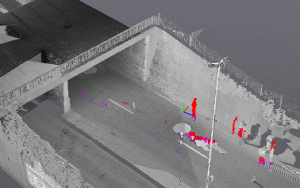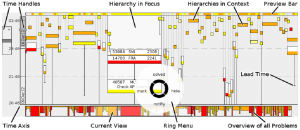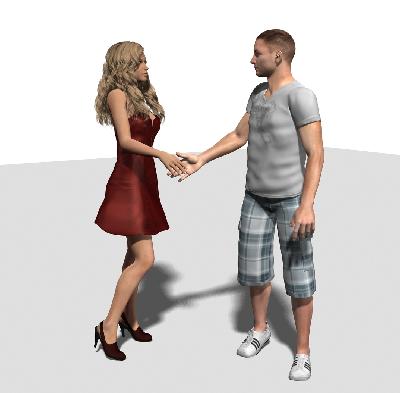 This year we are happy to announce that two papers from the Enercloud project got accepted to WSCG 2013, the 21st International Conference on Computer Graphics, Visualization and Computer Vision. Thomas Kanzok and Christian Günther will present their papers with the titles “Efficient Removal of Inconsistencies in Large Multi-Scan Point Clouds” and “A GPGPU-based Pipeline for Accelerated Rendering of Point Clouds” next week in Plzen.
This year we are happy to announce that two papers from the Enercloud project got accepted to WSCG 2013, the 21st International Conference on Computer Graphics, Visualization and Computer Vision. Thomas Kanzok and Christian Günther will present their papers with the titles “Efficient Removal of Inconsistencies in Large Multi-Scan Point Clouds” and “A GPGPU-based Pipeline for Accelerated Rendering of Point Clouds” next week in Plzen.
Research
VisRuption at EuroVis 2013
 Next week at EuroVis in Leipzig we finally present the results of our very successful collaboration with Lufthansa Systems AG. During the last two years we have analyzed the work of airline operations controllers at several airlines and have now come up with the tailored visualization tool VisRuption for the display of airline operations data which significantly outperforms the current state of the art. Thanks also to the cooperating airlines and to our partners from the department of cognitive science.
Next week at EuroVis in Leipzig we finally present the results of our very successful collaboration with Lufthansa Systems AG. During the last two years we have analyzed the work of airline operations controllers at several airlines and have now come up with the tailored visualization tool VisRuption for the display of airline operations data which significantly outperforms the current state of the art. Thanks also to the cooperating airlines and to our partners from the department of cognitive science.
Bachelor Defenses
In the last weeks, we had a set of three bachelor defenses which where the first ones for the group. The authors and titles were:
- Lukas Jürschick – Segmentierung des Spinalkanals unter Benutzung Statistical Shape Models aus MRT-Daten und Implementierung in MeVisLab
- Falk Süß – Automatische Nachbearbeitung von registrierten Punktwolken aus 3D-Scans unter Berücksichtigung geometrischer und temporaler Randbedingungen
- Christian Günther – Interactive Rendering of Point Clouds on General Purpose Graphics Processing Units Using OpenCL
We congratulate all students and hope for a good further collaboration.
EuroRV3 2013 Call for Papers
As promised in Vienna, EuroRV³ the EuroVis Workshop on Reproducibility, Verification, and Validation in Visualization continues and will be even more exciting in 2013. This year we will have a special focus on Human-centered Visualization, see the call for papers for more details. Besides we still solicit contributions on recent and future developments related to the reproducibility of newly developed visualization approaches, the verification of visualization and data-processing systems, the validation of visualization paradigms, and the effective incorporation of each of these into modern visualizations. This year’s workshop invites short papers (4 pages without references, 5 pages including references) and panel proposals (2 pages). The submission deadline is March 8, 2013. All accepted papers will be published in the Eurographics Digital Library and selected papers will be published in a special issue of Computing and Visualization in Science.
All those who unfortunately missed last year’s event can still catch up with the electronic proceedings including slides and videos.
Merry Christmas and a Happy New Year
The whole team of the Visual Computing Laboratory wishes all collaborators and friends a Merry Christmas and a good start into the New Year. The last year was full of new projects and steady growth of our group. We all are happy about the new challenges and collaborations which we hope to master in the upcoming year.
Successful Start of Eurostars Project “enercloud”
In April 2012 the enertec engineering ag, the Visualization and Computer Graphics Laboratory at Jacobs University, and the Visual Computing Laboratory at Chemnitz University of Technology started the joint project “enercloud: Instantaneous Visual Inspection of High-resolution Engineering Construction Scans”. The project is funded by EUREKA eurostars and the work on the Chemnitz’ side of the project will be carried out by Thomas Kanzok.
The first success of the project was already achieved with the publication of the paper “On-the-fly Luminance Correction for Rendering of Inconsistently Lit Point Clouds” in the Journal of WSCG 2012. We are looking forward to a further close and fruitful collaboration with our Swiss and German partners.
DFG Project “SmoothViz: Visualization of Smoothed Particle Hydrodynamics Simulation Data”
With the beginning of May the successful DFG project “SmoothViz: Visualization of Smoothed Particle Hydrodynamics Simulation Data” was prolongated and will be carried out in cooperation between the Visualization and Computer Graphics Lab of Lars Linsen in Bremen and the Visual Computing Lab of Paul Rosenthal in Chemnitz. The work on the Chemnitz’ side of the project will be done by Jonathan Fischer and we are looking forward to a close and fruitful collaboration.
DFG Research Training Group “Connecting Virtual and Real Social Worlds”
With the beginning of April a new DFG Research Training Group was established at Chemnitz University of Technology which is closely connected to the interdisciplinary competence center “Virtual Humans” and entitled “Connecting Virtual and Real Social Worlds”. The interdisciplinary group of 12 PhD students will deal with the challenges rising from the steady increase in digitization and virtualization and its social consequences. The Visual Computing Lab welcomes the new member Michael Heidt as part of the Research Training Group and we are looking forward to the exciting field between social and computer sciences.
ESF Early-Stage Researcher Group “The Smart Virtual Worker”
The members of the interdisciplinary competence center “Virtual Humans” have successfully applied for an ESF early-stage researcher group. The group consists of eight PhD-students and is entitled “The Smart Virtual Worker”. From 01.01.2012 till 31.12.2014 the members will develop new methods for the simulation of virtual workers and factories to effectively overcome the problems of todays aging mankind. The Visual Computing Group will be represented by Walentin Heft, who will be dealing with world modeling and visualization.
Competence Center “Virtual Humans”
With the beginning of April 2011, Chemnitz University of Technology has decided to establish an interdisciplinary competence center concerned with the topic “Virtual Humans”. The consortium consisting of working groups from work science, computer science (including my work group), medial science and process automation will head for achieving significant research results pushing the state of the art in the modeling of virtual humans.


